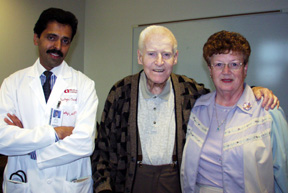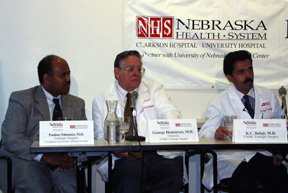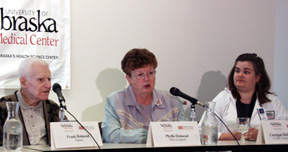 |
UNMC’s K.C. Balaji, M.D., left, with Frank and Phyllis Holmead. Mr. Holmead received the ileal conduit urinary diversion procedure. |
Surgeons at UNMC/NHS successfully performed the world’s first ileal conduit urinary diversion using a combination of the da Vinci Surgical System (computer assisted laparoscopic arms) and traditional laparoscopic techniques.
The combined technique now offers significant quality of life enhancement — with greatly reduced pain and recovery time — for thousands of patients needing urinary diversions for various diseases affecting the urinary bladder.
On Sept. 4, a team of five surgeons, led by K.C. Balaji, M.D., UNMC associate professor, section of urologic surgery, performed the complex ileal conduit urinary diversion on Frank Holmead, an 83-year retired architect from Sidney, Neb.
The medical team included George Hemstreet, M.D., Ph.D., UNMC chairman of urologic surgery; Paulos Yohannes, M.D., Creighton University assistant professor in the division of urologic surgery; and Dmitry Oleynikov, M.D., and Corrigan McBride, M.D., UNMC assistant professors in general surgery and co-directors of the Minimally Invasive Surgery and Robotic Initiative.
About the surgical procedure
The ileal conduit urinary diversion procedure consists of using a 6-inch section of bowel to connect the two ureters (the tubes that drain urine made by the kidneys) on one end, and turned into a stoma for external drainage through a stoma bag on the other end. Although urologists all over the world perform this procedure, almost all urologists are only trained in the open method — making large incisions to allow the surgeons hands inside the body to do the intricate maneuvers.
“The primary reason most patients suffer permanent loss of bladder function is due to bladder cancer,” Dr. Balaji said. “There are 50,000 cases of bladder cancer diagnosed in America each year now and at least 5,000 or more of these cases result in the complete removal of the bladder.”
 |
Creighton University’s Paulos Yohannes, M.D., and UNMC’s George Hemstreet, M.D., Ph.D., and K.C. Balaji, M.D., participate in Thursday’s press conference. |
Holmead’s bladder was severely scarred during radiation treatments for prostate cancer 20 years ago. He suffered from side effects for 15 years that included progressive incontinence due to irreversible damage to the bladder and external sphincter from the radiation, recurring bladder infections and constant wetness due to urinary incontinence necessitating two or three layers of adult diapers every day.
The treatment options
In the last six months, Holmead was hospitalized for multiple urinary infections, spasms and bleeding. Holmead and his wife, Phyllis, sought a second opinion from Dr. Balaji with regard to further treatment options. Dr. Balaji believed that instead of removing the entire bladder, an ileal conduit urinary diversion would produce the same symptomatic relief without the added risks of bladder removal in an elderly patient.
“Dr. Balaji made it clear from the beginning that this would be a new surgical method,” said Phyllis Holmead, Frank’s wife for 33 years. “His communication with Frank and I was outstanding. He never dodged or evaded a single question. He never talked down to us. He described in detail how he planned and rehearsed the surgery. And what really meant a lot to our family was that Dr. Balaji — during the 10 hours of surgery — repeatedly called me in the waiting area and updated us on what was being done and how everything was progressing.”
On the leading edge
Only a handful of medical centers even do traditional laparoscopic urinary diversions. The UNMC/NHS commitment to use the da Vinci Surgical System in diverse surgical procedures puts the medical center on a competitive footing to become the regional center — if not national destination point — for the world’s least invasive urinary diversion procedure, Dr. Balaji said.
 |
Frank and Phyllis Holmead and UNMC’s Corrigan McBride, M.D., address reporters. |
“Without the da Vinci, this would have been a lot harder to do — especially the intricate suturing that has to be done inside the closed body,” Dr. Balaji said. “The team effort was incredible. Dr. Hemstreet was very supportive of the procedure, involved in the planning process from the beginning and attended the surgery. Dr. Yohannes, the outstanding laparoscopic urologist, brought great expertise from Creighton throughout the entire procedure. Drs. Oleynikov and McBride also assisted in the planning processes, did a lot of the clinical laboratory work in advance of the surgery, and Dr. McBride did excellent work on the bowel resection for the conduit.
“This is the kind of collaboration that allows all of us to pursue new procedures and continue to build up Nebraska as a national competitor — if not leader — in increasing areas of medicine.”
The recovery
Holmead didn’t even have a recovery period in intensive care, a routine expectation for such an invasive surgery after traditional methods. He went to a regular room and left the hospital in three days. He was taken off intravenously administered pain medication within 24 hours of surgery.
Instead of a several inches long abdominal incision required under the traditional method, Holmead had four small incisions — each less than a half-inch long — where the da Vinci robotic arms were inserted. Phyllis Holmead said her husband had no bruising whatsoever at the insertion points and now it just looks like he has “a couple of extra navels.” In less than a week, Holmead was changing his own stoma bag and showing outstanding post-operative recovery.
“I feel fine,” Holmead said. “At my age and condition, this wasn’t about making some kind of radical change in my life. But it really means a lot to just be finally free from pain and recurring infections. And I no longer have to wear diapers for the first time in years.”